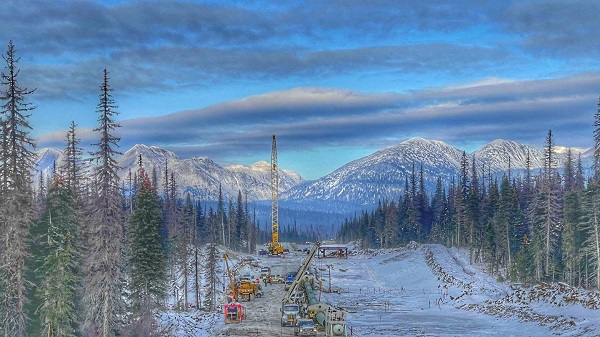Alberta
U.S. tariffs or not, Canada needs to build new oil and gas pipeline space fast

From the Canadian Energy Centre
Expansion work underway takes on greater importance amid trade dispute
Last April, as the frozen landscape began its spring thaw, a 23-kilometre stretch of newly built pipeline started moving natural gas across northwest Alberta.
There was no fanfare when this small extension of TC Energy’s Nova Gas Transmission Limited (NGTL) system went online – adding room for more gas than all the homes in Calgary use every day.
It’s part of the ongoing expansion of the NGTL system, which connects natural gas from British Columbia and Alberta to the vast TC Energy network. In fact, one in every 10 molecules of natural gas moved across North America touches NGTL.
With new uncertainty emerging from Canada’s biggest oil and gas customer – the United States – there is a rallying cry to get new major pipelines built to reach across Canada and to wider markets.
Canada’s Natural Resources Minister Jonathan Wilkinson recently said the country should consider building a new west-east oil pipeline following U.S. President Donald Trump’s threat of tariffs, calling the current lack of cross-country pipelines a “vulnerability,” CBC reported.
“I think we need to reflect on that,” Wilkinson said. “That creates some degree of uncertainty. I think, in that context, we will as a country want to have some conversations about infrastructure that provides greater security for us.”
Many industry experts see the threat to Canada’s economy as a wake-up call for national competitiveness, arguing to keep up the momentum following the long-awaited completion of two massive pipelines across British Columbia over the last 18 months. Both of which took more than a decade to build amidst political turmoil, regulatory hurdles, activist opposition and huge cost overruns.
On May 1, 2024, the Trans Mountain pipeline expansion (TMX) started delivering crude oil to the West Coast, providing a much-needed outlet for Alberta’s growing oil production.
Several months before that, TC Energy finished work on the 670-kilometre Coastal Gaslink pipeline, which provides the first direct path for Canadian natural gas to reach international markets when the LNG Canada export terminal in Kitimat begins operating later this year.
TMX and Coastal GasLink provide enormous benefits for the Canadian economy, but neither are sufficient to meet the long-term growth of oil and gas production in Western Canada.
More oil pipeline capacity needed soon
TMX added 590,000 barrels per day of pipeline capacity, nearly tripling the volume of crude reaching the West Coast where it can be shipped to international markets.
In less than a year, the extra capacity has enabled Canadian oil production to reach all-time highs of more than five million barrels per day.
More oil reaching tidewater has also shrunk the traditional discount on Alberta’s heavy oil, generating an extra $10 billion in revenues, while crude oil exports to Asia have surged from $49 million in 2023 to $3.6 billion in 2024, according to ATB analyst Mark Parsons.
 With oil production continuing to grow, the need for more pipeline space could return as soon as next year, according to analysts and major pipeline operators.
With oil production continuing to grow, the need for more pipeline space could return as soon as next year, according to analysts and major pipeline operators.
Even shortly after TMX began operation, S&P Global analysts Celina Hwang and Kevin Birn warned that “by early 2026, we forecast the need for further export capacity to ensure that the system remains balanced on pipeline economics.”
Pipeline owners are hoping to get ahead of another oil glut, with plans to expand existing systems already underway.
Trans Mountain vice-president Jason Balasch told Reuters the company is looking at projects that could add up to 300,000 barrels per day (bpd) of capacity within the next five years.
Meanwhile, Canada’s biggest oil pipeline company is working with Alberta’s government and other customers to expand its major export pipelines as part of the province’s plan to double crude production in the coming years.
Enbridge expects it can add as much as 300,000 bpd of capacity out of Western Canada by 2028 through optimization of its Mainline system and U.S. market access pipelines.
Enbridge spokesperson Gina Sutherland said the company can add capacity in a number of ways including system optimizations and the use of so-called drag reducing agents, which allow more fluid to flow by reducing turbulence.
LNG and electricity drive strong demand for natural gas
Growing global demand for energy also presents enormous opportunities for Canada’s natural gas industry, which also requires new transportation infrastructure to keep pace with demand at home and abroad.
The first phase of the LNG Canada export terminal is expected to begin shipping 1.8 billion cubic feet of gas per day (Bcf/d) later this year, spurring the first big step in an expected 30 per cent increase in gas production in Western Canada over the next decade.
With additional LNG projects in development and demand increasing, the spiderweb of pipes that gathers Alberta and B.C.’s abundant gas supplies need to continue to grow.
TC Energy CEO Francois Poirier is “very bullish” about the prosect of building a second phase of the recently completed Coastal GasLink pipeline connecting natural gas in northeast B.C. to LNG terminals on the coast at Kitimat.
The company is also continuously expanding NGTL, which transports about 80 per cent of Western Canada’s production, with more than $3 billion in growth projects planned by 2030 to add another 1 Bcf/d of capacity.
Meanwhile Enbridge sees about $7 billion in future growth opportunities on its natural gas system in British Columbia.
In addition to burgeoning LNG exports from Canada, the U.S. and Mexico, TC Energy sees huge potential for gas to continue replacing coal-fired electricity generation, especially as a boom in power-hunger data centres unfolds.
With such strong prospects for North America’s highly integrated energy system, Poirier recently argued in the Wall Street Journal that leaders should be focused on finding common ground for energy in the current trade dispute.
“Our collective strength on energy provides a chance to expand our economies, advance national security and reduce global emissions,“ he wrote in a Feb. 3 OpEd.
“By working together across North America and supporting the free flow of energy throughout the continent, we can achieve energy security, affordability and reliability more effectively than any country could achieve on its own.”
Alberta
Red Deer Justice Centre Grand Opening: Building access to justice for Albertans

The new Red Deer Justice Centre will help Albertans resolve their legal matters faster.
Albertans deserve to have access to a fair, accessible and transparent justice system. Modernizing Alberta’s courthouse infrastructure will help make sure Alberta’s justice system runs efficiently and meets the needs of the province’s growing population.
Alberta’s government has invested $191 million to build the new Red Deer Justice Centre, increasing the number of courtrooms from eight to 12, allowing more cases to be heard at one time.
“Modern, accessible courthouses and streamlined services not only strengthen our justice
system – they build safer, stronger communities across the province. Investing in the new Red Deer Justice Centre is vital to helping our justice system operate more efficiently, and will give people in Red Deer and across central Alberta better access to justice.”

Government of Alberta and Judiciary representatives with special guests at the Red Deer Justice Centre plaque unveiling event April 22, 2025.
On March 3, all court services in Red Deer began operating out of the new justice centre. The new justice centre has 12 courtrooms fully built and equipped with video-conference equipment to allow witnesses to attend remotely if they cannot travel, and vulnerable witnesses to testify from outside the courtroom.
The new justice centre also has spaces for people taking alternative approaches to the traditional courtroom trial process, with the three new suites for judicial dispute resolution services, a specific suite for other dispute resolution services, such as family mediation and civil mediation, and a new Indigenous courtroom with dedicated venting for smudging purposes.
“We are very excited about this new courthouse for central Alberta. Investing in the places where people seek justice shows respect for the rights of all Albertans. The Red Deer Justice Centre fills a significant infrastructure need for this rapidly growing part of the province. It is also an important symbol of the rule of law, meaning that none of us are above the law, and there is an independent judiciary to decide disputes. This is essential for a healthy functioning democracy.”
“Public safety and access to justice go hand in hand. With this investment in the new Red Deer Justice Centre, Alberta’s government is ensuring that communities are safer, legal matters are resolved more efficiently and all Albertans get the support they need.”
“This state-of-the-art facility will serve the people of Red Deer and surrounding communities for generations. Our team at Infrastructure is incredibly proud of the work done to plan, design and build this project. I want to thank everyone, at all levels, who helped make this project a reality.”
Budget 2025 is meeting the challenge faced by Alberta with continued investments in education and health, lower taxes for families and a focus on the economy.

Quick facts
- The new Red Deer Justice Centre is 312,000 sq ft (29,000 m2). (The old courthouse is 98,780 sq ft (9,177 m2)).
- The approved project funding for the Red Deer Justice Centre is about $191 million.
Alberta
CPP another example of Albertans’ outsized contribution to Canada

From the Fraser Institute
By Tegan Hill
Amid the economic uncertainty fuelled by Trump’s trade war, its perhaps more important than ever to understand Alberta’s crucial role in the federation and its outsized contribution to programs such as the Canada Pension Plan (CPP).
From 1981 to 2022, Albertan’s net contribution to the CPP—meaning the amount Albertans paid into the program over and above what retirees in Alberta received in CPP payments—was $53.6 billion. In 2022 (the latest year of available data), Albertans’ net contribution to the CPP was $3.0 billion.
During that same period (1981 to 2022), British Columbia was the only other province where residents paid more into the CPP than retirees received in benefits—and Alberta’s contribution was six times greater than B.C.’s contribution. Put differently, residents in seven out of the nine provinces that participate in the CPP (Quebec has its own plan) receive more back in benefits than they contribute to the program.
Albertans pay an outsized contribution to federal and national programs, including the CPP because of the province’s relatively high rates of employment, higher average incomes and younger population (i.e. more workers pay into the CPP and less retirees take from it).
Put simply, Albertan workers have been helping fund the retirement of Canadians from coast to coast for decades, and without Alberta, the CPP would look much different.
How different?
If Alberta withdrew from the CPP and established its own standalone provincial pension plan, Alberta workers would receive the same retirement benefits but at a lower cost (i.e. lower CPP contribution rate deducted from our paycheques) than other Canadians, while the contribution rate—essentially the CPP tax rate—to fund the program would likely need to increase for the rest of the country to maintain the same benefits.
And given current demographic projections, immigration patterns and Alberta’s long history of leading the provinces in economic growth, Albertan workers will likely continue to pay more into the CPP than Albertan retirees get back from it.
Therefore, considering Alberta’s crucial role in national programs, the next federal government—whoever that may be—should undo and prevent policies that negatively impact the province and Albertans ability to contribute to Canada. Think of Bill C-69 (which imposes complex, uncertain and onerous review requirements on major energy projects), Bill C-48 (which bans large oil tankers off B.C.’s northern coast and limits access to Asian markets), an arbitrary cap on oil and gas emissions, numerous other “net-zero” targets, and so on.
Canada faces serious economic challenges, including a trade war with the United States. In times like this, it’s important to remember Alberta’s crucial role in the federation and the outsized contributions of Alberta workers to the wellbeing of Canadians across the country.
-

 2025 Federal Election2 days ago
2025 Federal Election2 days agoTrump Has Driven Canadians Crazy. This Is How Crazy.
-

 2025 Federal Election2 days ago
2025 Federal Election2 days agoCarney’s Hidden Climate Finance Agenda
-

 2025 Federal Election2 days ago
2025 Federal Election2 days agoThe Anhui Convergence: Chinese United Front Network Surfaces in Australian and Canadian Elections
-

 2025 Federal Election2 days ago
2025 Federal Election2 days agoStudy links B.C.’s drug policies to more overdoses, but researchers urge caution
-

 Automotive1 day ago
Automotive1 day agoHyundai moves SUV production to U.S.
-

 Entertainment1 day ago
Entertainment1 day agoPedro Pascal launches attack on J.K. Rowling over biological sex views
-

 2025 Federal Election2 days ago
2025 Federal Election2 days agoWhen it comes to pipelines, Carney’s words flow both ways
-

 2025 Federal Election21 hours ago
2025 Federal Election21 hours agoAs PM Poilievre would cancel summer holidays for MP’s so Ottawa can finally get back to work




